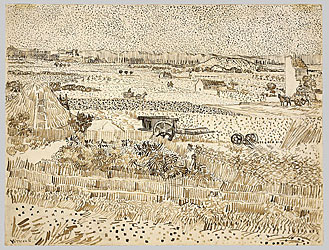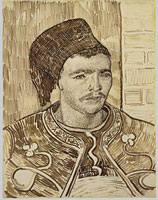|
Vincent
van Gogh: The Drawings
|
|
 |
Vincent
van Gogh
Cypresses, 1889
The Metropolitan Museum of Art,
New York
Roger Fund, 1949 |
Vincent
van Gogh (Dutch, 1853-1890(
Self-Portraits, 1887
Van Gogh Museum, Amsterdam (Vincent
van Gogh Foundation) |
October
18, 2005 - December 31, 2005
Special Exhibition Galleries, 2nd Floor
Metropolitan Museum of Art, NY
The first major exhibition in the United
States to focus on Vincent van Gogh's
extraordinary drawings was opened at The
Metropolitan Museum of Art on October
18. "Vincent van Gogh: The Drawings"—comprising
113 works selected from public and private
collections worldwide, including an exceptional
number of loans from the Van Gogh Museum
in Amsterdam— reveals the range and
brilliance of the artist’s draftsmanship
as it evolved over the course of his decade-long
career. Generally overshadowed by the
fame and familiarity of his paintings,
Van Gogh’s more than 1,100 drawings
remain comparatively unknown, although
they are among his most ingenious and
striking creations. Van Gogh engaged drawing
and painting in a rich dialogue, which
enabled him to fully realize the creative
potential of both means of expression.
A group of paintings are exhibited alongside
the related drawings. The exhibition will
remain on view through December 31.
Philippe de Montebello, director of the
Metropolitan, noted: "When people
think about Van Gogh, they tend to focus
on his paintings and his vivid, often
unconventional use of color. This exhibition—about
line, above all—demonstrates that,
masterfully used, black and white can
be as expressive as color. The works on
view will be a revelation to those who
believe they understand completely Van
Gogh’s artistic vision." Mr.
de Montebello continued: "Rarely
are these light-sensitive works placed
on display, and even more rarely are they
seen ensemble. Some series are reunited
here for the first time since they left
Van Gogh's studio; these and others are
unlikely to be shown together again in
our generation. This exhibition truly
provides a once-in-a-lifetime opportunity
to contemplate the graphic work of Van
Gogh in the broad context of his oeuvre."
 |
 |
Café
Terrace on the Place du Forum, 1888
Dallas Museum of Art |
Harvest
in Provence, 1988
National Gallery of Art, Washington
D.C. |
Retrospective in scope, "Vincent
van Gogh: The Drawings" traces the
artist's successive triumphs as a draftsman,
first in the Netherlands and later in
France, highlighting the originality of
his invention and the striking continuity
of his vision. Among the works exhibited
are an early series of large-scale views
of the garden at his father's vicarage
drawn by Van Gogh in March 1884. Distinctive
for their melancholy grandeur and regarded
as the high point of his early work as
a draftsman, drawings from this ambitious
suite, including two versions of Winter
Garden in contrasting horizontal and vertical
formats, are reunited in the present show.
Van Gogh produced most of his greatest
drawings and watercolors during the little
more than two years he spent working in
Provence. Compositions created in Arles
(February 1888–May 1889°©)
form the central portion of the exhibition,
bracketed by earlier and later works.
Largely self-taught, Van Gogh believed
that drawing was "the root of everything."
His reasons for drawing were numerous.
At the outset of his career, he felt it
necessary to master black and white before
attempting to work in color. Thus, drawings
formed an inextricable part of his development
as a painter. There were periods when
he wished to do nothing but draw. Sometimes,
it was a question of economics: the materials
he needed to create his drawings—paper
and ink purchased at nearby shops and
pens he himself cut with a penknife from
locally grown reeds—were cheap, whereas
costly paints and canvases had to be ordered
and shipped from Paris. When the fierce
mistral winds made it impossible for him
to set up an easel, he found he could
draw on sheets of paper tacked securely
to board.
Van Gogh used drawing to practice interesting
subjects or to capture an on-the-spot
impression, to tackle a motif before venturing
it on canvas, and to prepare a composition.
Yet, more often than not, he reversed
the process by making drawings after his
paintings to give his brother and his
friends an idea of his latest work. Over
a three-week period, between mid-July
and early August in 1888, he reproduced
some thirty of his paintings in pen-and-ink
drawings, which he sent to two artist
friends, Émile Bernard and John
Russell, and to his brother Theo. A number
of these highly stylized presentation
drawings are on view. The New York venue
of the exhibition uniquely features multiple
renditions of key motifs: Boats at Sea,
Saintes-Maries-de-la-Mer and Arles: View
from the Wheat Fields. Each of Van Gogh’s
paintings of these subjects is shown with
three pen-and-ink répétitions.
Never before seen together, these dossiers
offer a fascinating glimpse of Van Gogh's
successive reinterpretations—through
line—of vibrant color compositions.
 |
 |
Corridor
in the Asylum, 1889
The Metropolitan Museum of Art,
New York
Bequest of Abby Aldrich Rockefellerr,
1948
|
The
Zouave, 1988
Solomon R. Guggenheim Museum, New
York |
Several important series of drawings,
including the sweeping landscapes he composed
atop Montmajour, are featured. The artist
regarded the Montmajour suite of six drawings,
which range from elaborate panoramic vistas
of the countryside to spirited views of
the rocky mountain slopes with their windblown
trees, as his greatest achievement as
a draftsman. These landscapes are exceptionally
reunited for this exhibition. In addition,
a number of portraits and figure studies
will be on view, including a rare self-portrait,
one of only two such drawings known.
Van Gogh’s dialogue between drawing
and painting was most fully realized while
he was working in Arles and in nearby
Saint-Rémy. Several paintings from
this period are exhibited alongside related
drawings. In a splendid grouping, the
oil Harvest in Provence of about June
12, 1888—very seldom lent by the
Van Gogh Museum—is shown with a brilliant
preparatory watercolor and a dazzling
pen-and-ink drawing Van Gogh made after
his painting.
.
Exhibition Organization
The exhibition is organized by Colta Ives,
curator, Department of Drawings and Prints,
and Susan Alyson Stein, curator, Department
of Nineteenth-Century, Modern, and Contemporary
Art, both of the Metropolitan Museum;
and their colleagues at the Van Gogh Museum,
Sjraar van Heugten, head of collections,
and Marije Vellekoop, curator of drawings.
A version of the exhibition is on view
from July 1 through September 18, 2005,
at the Van Gogh Museum in Amsterdam.
The exhibition was jointly organized by
The Metropolitan Museum of Art, New York,
and the Van Gogh Museum, Amsterdam.
For
more information:
http://www.metmuseum.org
|



















